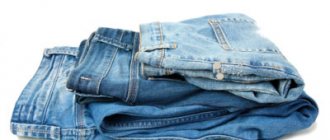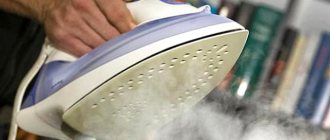Lucky women who have gotten rid of extra pounds and centimeters often face the problem of how to reduce their clothing size, because in their wardrobe there are favorite things that you don’t want to part with under any circumstances. Is there anything you can do to downsize your favorite outfit without having to have it altered in a tailor shop?
Indeed, at home with the help of simple techniques you can achieve excellent results. In this case, the cost of funds will be minimal. The only important condition for success is information about the fabric from which the clothes are made, and the rules for caring for the item, located on the product label. If there is no such information about the fabric, then you need to seek help from atelier specialists who have certain experience.
Features of denim care
Jeans are made from cotton and a small mixture of synthetics. Natural fiber shrinks from hot water, and the dye is washed out. The item may shrink or fade after washing or ironing. The main rule in caring for denim clothing is to maintain low to moderate temperatures.
How to care for denim clothes:
- do not wash, do not soak in water whose temperature exceeds 40 degrees;
- do not soak denim clothes with metal fittings for longer than 2 hours;
- use powder or gel for washing colored items;
- It is preferable to wash by hand;
- do not rub on a washboard;
- Wash denim clothes in a washing machine for no longer than 30 minutes;
- When washing by hand, rinse first in water of the same temperature, then again in cold water;
- dry in the fresh air, away from heaters and stoves;
- Iron denim from the inside out, through moistened gauze or slightly damp.
Jeans shrink in hot water. At the dawn of denim fashion, denim clothes were washed without taking them off. This method helped to fit the item to the figure. Stretched denim can be reduced to its original size by keeping it in hot water. But during normal washing, you should not overheat it, especially a denim jacket. Once it shrinks, it will be difficult to put on over a sweater. If soaked for a long time, metal parts will rust. Dry clothes will leave brown marks underneath. A very dirty item can only be soaked for half an hour.
Proper drying methods
The faster a washed item dries, the more likely it is that it will shrink in size. The fact is that during normal drying, which lasts more than 10 hours, the fibers have time to straighten and fully recover. With rapid drying, there is a sharp reduction in fibers and the space between the threads without the possibility of recovery.
Dry clothes prepared for shrinking as follows:
- hang it near heating radiators or a stove, and in summer - in a sunny place;
- for greater effect, place a fabric under the product that absorbs moisture well;
- use a dryer.
To prevent the trousers from shrinking during drying, they are hung with clothespins.
Explanation of the label
The manufacturer informs you under what conditions to wash the jacket using symbols:
- container with water and a number - washing temperature;
- triangle - whitening;
- letter in a circle - dry cleaning;
- iron with dots - ironing;
- a square with vertical stripes is a drying method.
The label of a simple denim jacket without lining often indicates a water temperature of 40 degrees. A crossed out triangle means no bleaching. The letter "P" is enclosed in a circle. The symbol indicates that the item is subject to standard dry cleaning. Two dots are placed on the iron, indicating ironing at 150 degrees. Vertical stripes in a square are a sign indicating hanging drying.
Useful tips on how to easily and accurately sew a jacket to size
To ensure the job goes smoothly, consider the following tips.
- The sequence of actions may be different, but it is better to first turn it out and then tear it apart.
- There is no need to suture or even affect the armhole of the sleeve and the fit of the shoulder. In this case, you will need to cut out the top of the sleeve.
- It must be remembered that the lining should hang over a short distance in order for the fit to be loose.
- Make sure that the length of the armhole on the pattern and the length of the rollback match.
- When securing materials during work, use pins for convenience.
- You can add an extra button at the waist.
- Make the undercut on the back closer to the middle.
As you can see, sewing a jacket is not as difficult as it seemed.
Exquisite options for tying a scarf around your neck
What to wear with a gray sweater?
How to wash in an automatic washing machine
Preparing and washing a denim jacket:
- fasten the zipper, all buttons, turn the item inside out;
- select delicate mode in the machine menu;
- pour washing gel into the powder compartment;
- add conditioner to the special compartment.
For a blue jacket, the recommended water temperature is 40 degrees, for a black jacket - 30 degrees. Some washing machine models have a hand wash mode, which is also suitable for a denim jacket. The menu also includes a special program for washing denim items.
In programs for delicate fabrics, the required minimum spin speed is set.
If your lightweight jacket is hand washable, you can still machine wash it, but the spin cycle should be turned off. It is useful to include an additional rinse so that stains from the detergent do not appear on the fabric.
How to downsize cotton clothing
How to wash cotton clothes to make them shrink, and is it possible to do this? There are three ways to reduce the size of items made from such fabrics.
Automatic washing. Exposure to high temperatures will reduce the size of clothing if washed at the highest temperature, but this method is only safe for plain light-colored fabrics.
Colored wardrobe items are reduced during automatic washing as follows:
- water temperature – 60 degrees;
- detergent - for colored fabrics, so that the color scheme of the design does not fade;
- spin – standard mode;
- drying - automatic in a machine at high temperature, either on a radiator or using an electric dryer.
Handwash. We reduce the size of cotton ones using contrast washing.
We process the clothes so that they fit as follows:
- To ensure that cotton items shrink to the same size, soak them in boiling water for five minutes. By extending the soaking time by another five minutes, the items are reduced by another size. That is, if an item is in boiling water for 10 minutes, then it shrinks 2 sizes;
- then the clothes are placed in a container with very cold water for 20 minutes and then rinsed.
By washing the item in this way, you can easily ensure that it shrinks to the desired size. You can reduce the size of cotton clothes without washing by ironing them at maximum temperature in the steam mode.
Features of hand washing
Since denim items fade, it is not recommended to wash them with clothes made from other fabrics. But running a washing machine with one item is not economical. To save electricity, you can wash your denim jacket by hand:
- fill the bath with warm water, up to 40 degrees;
- pour powder or pour gel; it is good to use the product for denim or colored items;
- instead of conditioner, you can add a tablespoon of vinegar;
- rub the fabric with a brush.
The powder should be well dissolved in water before immersing the jacket. Do not sprinkle the product on top of the jeans. The universal powder changes color, oxidizes zippers, buttons, and rivets. Undissolved particles remain on clothing. Gel for washing denim protects color, does not foam and is quickly washed off.
If the jacket is decorated with fur, it is better to wash it by hand. The active substances in detergents destroy the leather base of natural fur. Artificial pile also becomes coarser and bristles from mechanical washing. Before washing, stains from food and spilled juice are rubbed with laundry soap, dishwashing detergent, and sprinkled with soda. Apply a little kerosene to greasy marks. Then the item is washed as usual. Instead of regular detergents, it is better to use a special gel for jeans.
How to properly alter a jacket depending on the material of manufacture
Let's look at the most popular types of fabric:
- Suede , sheepskin coat. If your clothes are made from the presented material, then it is better to contact the studio. This is explained by the fact that in this case the probability of poor performance is high. These fabrics require special equipment.
- The size of clothing can easily be changed at home if it is made of artificial fabric or textiles.
How to sew a leather jacket
To begin with, the standard shenanigans: rip the clothes. For a leather product, for convenience, make a pattern and lay it out according to the material. Circle each detail separately.
ATTENTION!
Don't forget about the allowances (about 1-2 cm on top, 2-3 cm on bottom).
When cutting out leather, you should take sharp scissors and attach the parts with non-woven material. Sewing material made specifically from leather differs from others in that it is strictly forbidden to sweep it away, as this will leave traces. Therefore, we equip the sewing machine with a special Teflon foot. Don't forget to install a thick corner. Now you can create a line of three millimeters. Next, turn the jacket inside out and iron it once. We glue the allowances and leave the product for a few minutes until the glue dries.
How to dry jeans correctly
Actions after hand washing:
- do not squeeze the jacket too hard, let the water drain;
- straighten, hang on hangers;
- dry on the balcony in the shade.
After machine washing, the jacket is unbuttoned, turned right side out, and also hung on hangers on the balcony. If the fabric is periodically straightened, the item will not need to be ironed after drying. It is not recommended to dry denim with a hairdryer. The hot air will make it rough and hard.
Things dried in the sun lose their elasticity and fit tightly to the body. It is inconvenient to move in a hard jacket until it gets worn out again.
Pre-soak method
Suitable for raw denim. The world of raw denim is confusing. If only because half the population tells you not to let a drop of water near your new jeans for at least six months, while the other half blindly swears that you should throw them in the bath before you even wear them. So who is right? Depends.
Raw denim can be sanforized or unsanforized. Sanforized denim is pre-shrunk, but unsanforized denim is not. In the latter case, you need to get rid of the initial shrinkage yourself by first soaking the jeans. If you buy unsanforized jeans, be sure to buy them a size or two larger for this reason.
To take a bath, pour 5-10 cm of hot water (although not too hot) into the bathtub. Turn your jeans inside out and place them in water until it cools completely. You can place bottles on them to prevent them from floating to the surface.
After this, carefully remove them and hang them to dry.
Common Mistakes
How to ruin a denim jacket:
- rub the fabric in your hands;
- machine wash at 60 degrees;
- remove stains with bleach;
- dry by throwing it over a clothesline;
- hang a damp item in the sun, next to the radiator, above the stove.
Jeans are cleaned in water with a clothes brush. To remove dirt, soap the cloth, not the brush. At temperatures above 40 degrees the fabric becomes lighter. Jeans should be dried in a ventilated area without using an electric dryer.
How to sew a jacket in several sizes
For this method you will need tracing paper . It must be applied strictly along the seams, both from the bottom of the clothing and from the top. On top of the tracing paper, mark with a pen the length along which you will need to sew in the future. Place the first point directly on the jacket, it should be at the bottom. And the other in the middle of the distance from the edge of the stitch to the fitting line itself. Then connect them. Therefore, further work will be done on a sewing machine.
- It is necessary to sew one line and remove the tracing paper.
- Use scissors to open the factory stitch and cut off one centimeter of allowance from the new stitch.
- Through the seam that will be on the lining, you can turn the jacket inside out.
- Then rip it apart and reduce the fabric along the seams at the same distance. As a result, the lining is connected to the outer part.
Professional shrinking of jeans
Let's face it, using heat to shrink any material is always going to be risky. It's bad for the fabric, bad for the dye, and will never produce the results you want. Alternative? Take your ill-fitting jeans to someone who has made a career out of making clothes fit people.
Your local tailor will be able to discuss with you exactly how you want your jeans to fit and can then alter them accordingly. A pot of boiling water will never be able to offer the same level of service, so a real person will always be the best option when it comes to adjusting clothing.
Bring to a boil
Suitable for aggressive shrinkage over the entire surface. Before we continue, please note that this method only works on 100% cotton jeans. If your jeans are made from an elastane or polyester blend, don't do this. This is also quite an extreme option, so only try it if you can afford to buy others if things go wrong.
To start, you'll need a large pot of boiling water. Turn the jeans inside out, lay them down, let them simmer for about 30 minutes and add salt and pepper to taste (not really). Once the jeans have boiled, carefully remove them from the pan and place them in the dryer on the highest setting.
Your jeans should shrink a lot when you take them out of the dryer. But be careful, there is a good chance that your jeans will eventually stretch to some extent, and if you repeat this process, they will quickly lose color.
By ironing
Sometimes you just need to fix your baggy butt or knees before you hit the road. Using an iron is a quick and easy way to make these small corrections without causing any nuclear damage. For best results, use an iron with a spray function. Otherwise, use a spray bottle.
Spray the area you want to lift and then go over it with the iron at high speed, being careful to keep it moving. Do this until the fabric is completely dry and repeat as many times as necessary.
Share on social networks:











